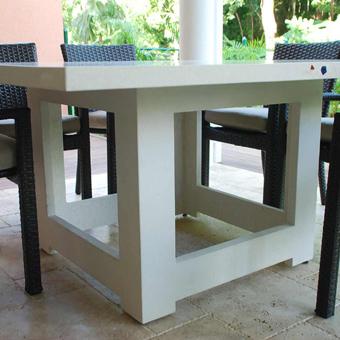Q: I am about to start building indoor/outdoor concrete tables with square tubular welded frames. Can you recommend how best to fix the concrete top to the steel frame? I’m not sure if it’s best to cast some type of flanged nut into the concrete and bolt the frame to it, or try something else. If there is some hardware that would provide a simple solution, I’d love to know about it.
A: I like to use stainless steel tee nuts embedded in the concrete.
There are a lot of considerations when it comes to attaching legs to a concrete top. Connecting legs to a table is a classic challenge, and solutions to it are seen in all forms of table construction. Different materials require different solutions:
- Wood legs often require an apron and a stretcher or trestle to keep the legs from wobbling or breaking off if the table is dragged across a floor.
- Steel legs tend to be simpler, since steel can be bolted or welded to create a much more compact, strong and rigid connection.
- Concrete is a relatively poor material to make legs out of, since the legs need to be fairly massive to provide the necessary bending stiffness that table legs require, and in order to make a strong and rigid connection to the top.
Designing a table and legs involves a number of choices and decisions; those decisions and choices are both structural and aesthetic and are interdependent. Factors that affect both include top and leg material (steel, wood, GFRC, etc.) are:
- aesthetics
- top thickness
- leg location
- leg shape
- weight limits
- handling characteristics (will this be moved once or many times)
- seating location
- etc.
Aesthetics usually drive a design, so I suggest you start there.
The table’s top thickness depends upon the span and what is providing the strength. This decision influences the structural design of the GFRC top itself, especially if the GFRC is expected to be self-supporting (meaning it’s not sitting on a structural frame). It also affects how the top and legs are connected. Thin tops can’t span long open spaces and don’t provide much strength for an embedded anchor, while thicker tops can (and do). A good compromise between strong legs and a thin top would be to weld the legs to horizontal steel beams that connect the legs together and keep them rigid and strong. The horizontal steel beams form a frame that also fully supports a thin GFRC slab. The slab can simply sit on top of the frame unbonded, or it could be glued to it using construction adhesive.
Alternatively, if the legs of the table are separate and bolted to the GFRC top, then the top must be made to be fully self-supporting. This forces the table top to be thicker, which in turn affects aesthetics. In addition, the top must have stout anchors cast into it where the legs bolt to the top (and the leg design must accommodate such a connection method). Stainless steel tee nuts can be used for this connection.
Tee nuts are usually used in furniture made of plywood or particle board. The tee nut forms a solid anchor within the concrete top where a machine bolt can thread into. Each tee nut should be buried at least 1″ into the concrete.
When embedding the tee nut, grease the nut and the bolt threads (I use Vaseline), then run the greased machine bolt into the nut to keep concrete out of the threads. A good tip is to run the bolt through the nut so about 1/4″ of bare thread extends beyond the base of the tee nut. This will create a pocket inside the concrete and will keep the bolt from bottoming out (and possibly creating a blowout). Use a jig, as shown, to keep the nut and the bolt hole perfectly vertical in the concrete.
3-Dimensional Concrete Table
You can also make the table “legs” out of concrete. For example, see this design for a 3-dimensional concrete table base I call the “Cube Table Base”. This is cast as a single piece of GFRC, as explained in this self-study course. For more creative concrete projects, see this page.



